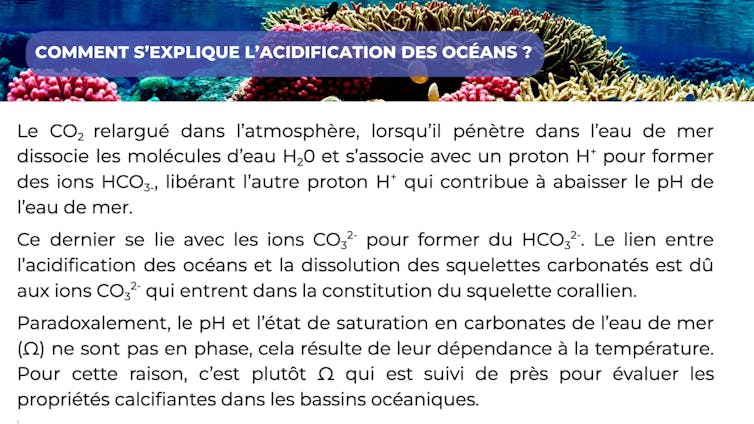Faced with marine heat waves and ocean acidification, coral reefs are in great danger, and with them, an essential source of food, protection of coastlines, and a reservoir of biodiversity. To try to avoid the worst, scientists are doing everything to help corals adapt to these scourges.
The experience was eloquent. We were 750 coral reef specialists gathered in Naples for the 2024 European Congress. During his speech, a colleague got us all up and then listed the different half degrees of warming possible by the end of the century, ranging from 1.5°C to 5°C, asking people to sit back down when the value of warming that she had a feeling it would be pronounced.
Unquestionably, most of us were convinced that warming will be greater than 1.5°C, the maximum elevation negotiated during the Paris agreement in order to maintain the good ecological status of coral reefs but also maintaining their vital roles for humanity. Because these reefs protect the coastlines from destructive swells, provide food resources to local populations, give cultural stability to their societies and are a conservatory of biodiversity, with more than a quarter of marine biodiversity on only 0.2% of the surface of the islands. oceans. Thanks to its overseas territories, France is the 4e country with the most in the world. This says a lot about his responsibility to preserve them.
If we estimate that 1.5 degrees will be exceeded, it is high time, in addition to studying the impact of extreme heat on corals, to know their capacities for resistance, adaptation or resilience, and human actions already taken to help them survive climate shocks.
But before examining these possible margins of maneuver for corals in the face of the numerous scourges they suffer, let us first begin by understanding why corals are vulnerable to heat.
Heat waves and their effects on tropical corals
Tropical corals live in marine waters whose temperature is very close to their tolerance limit. This is why heat waves today constitute the major risk of coral mortality.
During these thermal anomalies, the corals bleach, that is to say they expel brown microalgae (zooxanthellae or Symbiodiniaceae) from their transparent tissues, revealing their white limestone skeleton through transparency. However, these microalgae live in a mutually beneficial association with their coral host. They nourish it, we then speak of autotrophy, and are in return protected from predators in the tissues folded into its skeleton. By expelling them, the corals therefore put themselves in serious danger. Even if it is possible for them to feed by consuming zooplankton (heterotrophy), this mode of feeding does not seem to intervene effectively against bleaching. The corals will be able to recover if the heat wave is not too intense or too long, otherwise they will die of starvation.
Provided by the author
Susceptibility to coral bleaching varies among species, their life history traits, and their ecological niche. Opportunistic species such as branching corals of the genus Acropora are very vulnerable, others are thermotolerant, that is to say able to resist temperature changes, such as Porites. It also depends on the regions where corals live and therefore their thermal history.
All regions of the intertropical belt have been impacted by bleaching events, from the Caribbean Sea, the Red Sea, the Seychelles, Australia, New Caledonia, French Polynesia, etc. Vast expanses of coral have been irreparably destroyed. With a succession between 2004 and 2024 of six heat waves unprecedented in four centuries, five of which were accompanied by major bleaching, the Great Barrier Reef in Australia is now in danger of disappearing.
However, the coral triangle where the diversity of coral species is maximum (Philippines, Indonesia), bathes in waters whose thermal history and associated modeling are more favorable than outside, with greater coral resistance.
Ocean acidification and its effects on tropical corals
At the same time, corals are sensitive to ocean acidification because the formation of their limestone skeleton (calcium carbonate CaCO3) is linked to the chemistry of seawater. The drop in pH leads to a reduction in the concentration of carbonate ions which corals use to build their skeletons (see box). For example on the Great Barrier Reef, the growth of corals of the genus Poriteswith a massive and porous skeleton, has been affected by the acidification of seawater since 1950 with a loss of skeleton density of around 13%. This weakening makes them more vulnerable to bioerosion, dissolution and storm shock, suggesting that the reefs of the future will be less resilient and more vulnerable in the 21st century.

Provided by the author
Natural solutions (and more) to remedy these major disturbances
Faced with all these ills, are corals all inevitably doomed to disappear in the coming decades? Fortunately not! They demonstrate adaptation skills.
Thus, bleaching is a process of rapid adaptation of corals, which can reshuffle the species of microalgae that live in their tissues. They expel those that can no longer allow them to grow with the warming of temperatures (the Cladiocopium for example) for the benefit of those allowing them to withstand the new temperatures. This is where the robust comes into play Durusdiniumwhich gave scientists a glimmer of hope. Durusdinium glynnii allows corals of the genus Pocillopora of becoming thermotolerant on Pacific reefs.
However with Durusdinium trenchiithis comes at the cost of the growth of the host because these resistant microalgae transfer very few nutrients to it to feed on, negatively impacting the resilience of the reefs and their long-term recovery. But cultivated strains of Cladiocopium proliferum evolved with respect to heat make it possible to compensate for this false compromise with the growth of the host.
Corals also host bacteria, viruses and fungi in their cells which, along with zooxanthellae microalgae and other bacteria (endolith cyanobacteria), constitute their microbiome. Certain bacteria and “good” viruses also contribute to improving the resilience capacities of their host through numerous mechanisms made possible thanks to short generation times, large populations and a high renewal rate. Like probiotics, manipulating the microbiome therefore makes it possible to increase the tolerance of corals to stress.
At the same time, tropical corals have rapid adaptation processes, independent of Darwinian evolution, which modifies their genome by natural selection through multiple generations and can take place over millions of years. Chemical modifications of DNA, in particular by adding methyl groups, intervene to regulate the expression of genes without modifying the DNA sequence. This plasticity is transmitted between generations. It could even be that these modifications are ultimately recorded in the genome.
The acidification of seawater also induces these chemical modifications of DNA in coral species sensitive to environmental changes and this is accompanied by a decrease in the calcification of their skeleton. The effects on corals vary greatly since the most robust species show no reaction to the drop in pH.
“Supercorals” also thrive in waters with low pH (7.2 instead of 7.9 on nearby reefs), high temperatures and low oxygenation at low tide, such as in the semi-enclosed lagoon of Bouraké in New Caledonia. Strong daily variations linked to the tide and particular nutrient concentrations explain this adaptation to extreme environmental conditions.
Human interventions to remedy these major disruptions
As we can see, certain corals are capable of remarkable adaptations to the warming and acidification of waters. Plus, scientists come to their rescue.
Several initiatives have been launched to help corals survive in heated waters. This is what we call assisted evolution, i.e. breeding ex situ of species selected on the basis of their ability to adapt to temperature anomalies, in order to select their gametes. The goal of assisted gene flow is to ensure the translocation of adaptive genes between populations to restore coral populations in destroyed habitats. Cryopreservation of mobile sperm from male corals is also a promising initiative which aims to compensate for spawning events by fertilizing females.
A strong call for a Caribbean-wide program was also made at the 2024 European Coral Reef Symposium to share genetic resources across national borders and beyond the species range. This involves taking corals to keep them reared in aquaculture farms. ex situ. The objective is to conserve more thermotolerant species to repopulate decimated areas in due time. Similar reflection is also underway regarding the south-west Indian Ocean region.
But all these possibilities, natural or favored by man, will only work if the rise in temperature remains constrained and does not exceed a maximum warming trajectory of 2.5°C by 2100. However, the efforts made between 2005 and 2020 were largely insufficient since carbon emissions during this period would lead to a temperature increase of 4 to 5 °C in 2100. This projection must be weighted by uncertain positive elements (decline in the use of fossil fuels and carbon emissions, increasing share of renewable energies) but also negative elements (changes in the atmosphere which seem to accelerate global warming).
It is clear that the urgent need to take immediate action to control CO emissions2 is completely out of step with the consideration of these vital problems in the French political and societal debate, as well as abroad.

